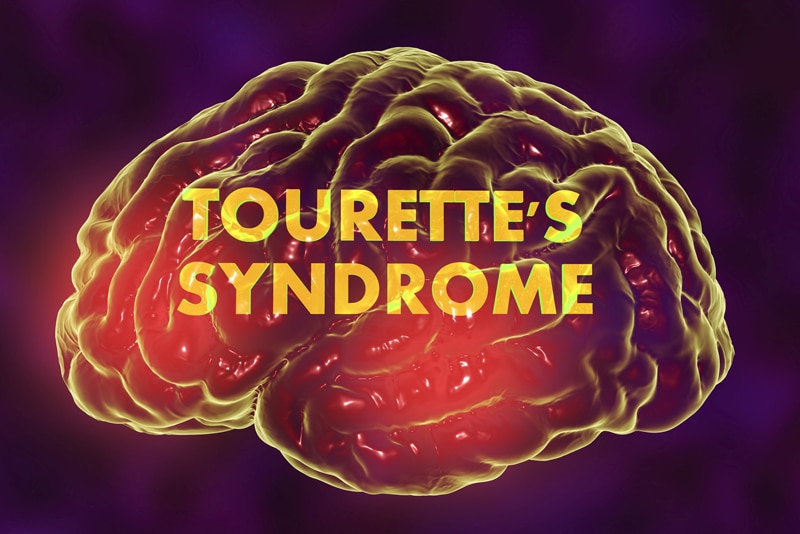An abnormal neurological disorder, Tourette syndrome (TS) is characterized by repeated, involuntary physical movements and vocal outbursts called tics. Generally, tics show up between the age of 2 and 15 years, with the average being around 6 years of age. In fact, men have about three to four times more chances than women to develop this condition. Also called Tourette’s disorder or simply “Tourette’s”, the condition is named after Dr. Georges Gilles de la Tourette – a French neurologist who in 1885 – first described a series of children and adults with the condition. The exact cause of this condition is unknown and there is no way to prevent it. An inherited genetic defect may play a minor role in developing this condition. In most cases, people with this condition don’t need any treatment as the symptoms may not be troublesome. Tics often lessen in intensity or become controlled after the teen years. Neurologists, neurosurgeons or other specialists who treat Tourette’s disorder need to correctly document the same in the patient’s medical records. Opting for billing services from a reliable neurology medical billing and coding company can simplify the documentation process.
According to a 2019 report from the National Institute of Neurological Disorders and Stroke (NINDS), about 200,000 people in the United States exhibit severe symptoms of Tourette syndrome. It is estimated that as many as 1 in 100 Americans experience mild symptoms. The exact cause of this condition is not known. However, it is most likely caused by a combination of genetic and environmental factors. Chemicals in the brain that transmit nerve impulses including dopamine and serotonin may play an active role.
Identify the Symptoms
Symptoms of this condition may vary from one person to another. Reports suggest that TS normally begins in early childhood between the age group of 5 to 8 years and may be lifelong. Often, TS symptoms become worse for children who enter their early adolescence, but later improve in the teens or early 20s. Some people with TS experience complete remission of symptoms after adolescence. In adulthood, the condition does not worsen and assumes a steady pattern.
Tourette syndrome is basically a tic syndrome. Tics – sudden, brief, intermittent movements or sounds – are the hallmark sign of Tourette syndrome. Tics as mentioned above are involuntary muscle spasms that consist of abrupt intermittent twitches of a group of muscles, and can range from mild to severe. The severity of symptoms can significantly affect a person’s ability to communicate, perform daily activities and improve quality of life. Tics are classified by type, as in motor or vocal. Further classification includes simple or complex tics.
- Simple tics – are sudden, brief and repetitive tics that involve a limited number of muscle groups
- Complex tics – involving several muscle groups, these tics involve coordinated patterns of movements
The most frequent symptoms of different types of tics include – eye blinking, touching or smelling objects, bending or twisting, coughing, eye darting, head jerking, mouth movements, nose twitching, repeating observed movements, repeating one’s own words or phrases, shoulder shrugging and throat clearing. Several behavioral complications and conditions can occur with TS which include – attention-deficit/hyperactivity disorder (ADHD), Autism, obsessive-compulsive disorder (OCD), learning disabilities, sleep disorders, depression and anxiety disorders and headaches.
How Is Tourette Syndrome (TS) Diagnosed?
There is no specific test that can specifically diagnose TS. Initial diagnosis of the condition will be based on the patient initial line of symptoms. There are several other criteria used to diagnose TS which include –
- Both one motor tic and one vocal tic need to occur (not necessarily at the same time), for at least one year
- Tics beginning before age 18
- Tics aren’t caused by medications, other substances or another medical condition
- Tics must change over time in location, frequency, type, complexity or severity
In some cases, both motor and vocal ties can be caused by conditions other than TS. In such cases, to identify the correct causes, physicians may recommend performing several imaging studies like MRI, CT, or EEG and blood tests.
As there is no specific cure for Tourette Syndrome (TS), treatment modalities aim to reduce the severity or complications of symptoms. Some of the common treatment modalities administered include – medications like Fluphenazine, haloperidol (Haldol), risperidone (that help block or lessen dopamine), Botox injections, ADHD stimulants, Central adrenergic inhibitors, antidepressants and anti-seizure medications. Neurological treatments like deep brain stimulation (DBS) and other therapies like psychotherapy and behavioral therapies are also administered.
Neurologists, neurosurgeons or other physicians who diagnose, screen and treat TS must carefully document these tests and procedures using the correct medical codes. Billing and coding services offered by established medical billing and coding companies can help physicians in using the correct codes for their medical billing process. In ICD-10, F95.2 – Tourette’s disorder is the specific code used to diagnose this neurological condition.
People living with Tourette syndrome may experience feelings of being isolated. Taking advantage of the available resources can help people cope with TS. Support groups and group therapy may help patients better manage the feeling of with depression and social isolation.
As neurology medical billing and coding is challenging and time-consuming, physicians can consider hiring medical coding services. This would ensure accurate reporting of diagnostic details and help avoid claim denials or delays.




